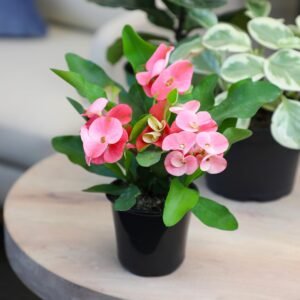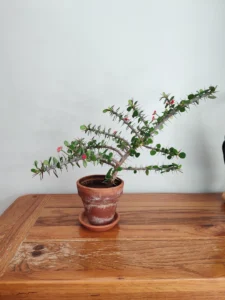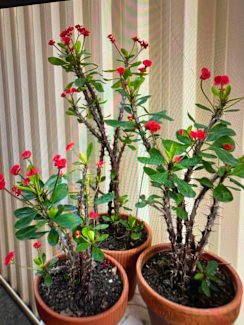Click Any Section to Learn More
🏡 Why Choose Crown of Thorns (Euphorbia milii) for Indoors?
Crown of Thorns (Euphorbia milii) is an excellent indoor plant thanks to its resilience, vibrant year-round blooms, and minimal care requirements. Its ability to thrive in dry conditions and tolerate indirect sunlight makes it a favorite for both beginners and seasoned plant enthusiasts.

🌟 What Makes Crown of Thorns (Euphorbia milii) So Attractive?
Vivid Color: Continuous, colorful bracts (in red, pink, or yellow) add a cheerful touch.
Unique Structure: Its thick, thorn-covered stems and glossy leaves offer bold visual contrast.
Low Maintenance: Thrives even with minimal care, perfect for busy lifestyles.
🛠️ Special Capabilities of Crown of Thorns (Euphorbia milii)
Highly Drought-Tolerant: Stores water in stems and roots.
Air Purifying Qualities: Like many succulents, it helps improve air quality.
Year-Round Blooming: With the right conditions, it flowers continuously indoors.
💚 Psychological Benefits of Crown of Thorns (Euphorbia milii)
Mood-Boosting Blooms: Vibrant flowers uplift your space and spirit.
Low-Stress Care: Easy maintenance offers a sense of calm and achievement.
Tranquility: Adds natural beauty, which enhances indoor serenity.
🌍 Origin & Botanical Description
Native to Madagascar, the Crown of Thorns is a spiny succulent shrub known for its thick stems, showy bracts, and glossy green leaves. It’s a hardy plant perfect for arid environments—and adapts beautifully to indoor conditions.
⚠️ Toxicity to Pets and Humans
Crown of Thorns (Euphorbia milii) contains a milky, latex-like sap that is toxic to both pets and humans if ingested or if it comes into contact with skin or eyes.
Affected Group Effects of Exposure
Humans Skin contact with the sap may cause irritation, redness, or rashes. If the sap gets into the eyes, it can cause serious irritation or temporary vision issues. Ingestion may result in nausea, vomiting, or stomach discomfort.
Pets (Dogs & Cats) Ingestion may cause drooling, vomiting, loss of appetite, or mouth irritation. Contact with the sap may also lead to skin or eye irritation.
Safety Tips:
Wear gloves when pruning or repotting the plant.
Keep the plant out of reach of children and pets.
Wash hands immediately after handling the plant.
Seek medical attention or consult a vet if ingestion or sap exposure occurs.
Source: ASPCA – Euphorbia milii
Additional Reference: Pet Poison Helpline – Euphorbia Species.
🧽 Leaf Cleaning Method
Wipe with Damp Cloth: Removes dust to enhance shine and photosynthesis.
Avoid Chemicals: Skip commercial leaf shines—they can harm foliage.
Regular Maintenance: Clean monthly for optimal health and appearance.
🌸 Special Care for Blooming
Step Description
Sunlight Ensure 4–6 hours of bright, indirect light.
Watering Let soil dry between waterings—avoid overwatering.
Fertilizer Feed every 2–3 months during spring/summer.
Environment Keep warm (65–80°F / 18–27°C), away from drafts.

🌿 Creative Display Ideas
Use textured ceramic pots to complement the bold form.
Place near a sunlit window on a stand for height and visibility.
Combine with succulents or minimalist decor for contrast and impact.
🏺 Recommended Pot Features
Material:Ceramic, plastic, or terracotta with drainage.
Size: Slightly larger than root ball; avoid oversized pots.
🌱 Recommended Soil for Crown of Thorns (Euphorbia milii)
Soil: Cactus or succulent mix with perlite or sand for drainage.
pH: Ideal 6.0 to 7.5 (slightly acidic to neutral).
💧 Watering Tips for Crown of Thorns (Euphorbia milii)
Tip Description
Frequency When top 1–2 inches of soil feel dry
Water Type Room temperature, non-chlorinated water
Caution Avoid overwatering—can cause root rot
Method Water thoroughly, allow excess to drain
🌿 Fertilizing Tips for Crown of Thorns (Euphorbia milii)
Type : Use a balanced liquid (10-10-10 or 20-20-20) or cactus fertilizer.
Frequency: Every 4–6 weeks in spring and summer. Skip in winter.
Organic Options: Fish emulsion, compost tea (diluted).
Application: Apply to soil, not foliage. Water after fertilizing.
🌡️ Ideal Indoor Environment for Crown of Thorns (Euphorbia milii)
Condition Ideal Setup
Air Good circulation, low humidity.
Water Water when soil is fully dry; avoid soggy roots.
Light Bright, indirect light; tolerates some direct sunlight.
Temperature 65–80°F (18–27°C), avoid cold drafts.
Humidity Moderate to low; prefers drier conditions.

🪴 Everything You Need to Know Before Repotting Crown of Thorns (Euphorbia milii)
Best Time:
Season: Spring or early summer (during active growth).
Time of Day: Morning (minimizes transplant shock).
🧰 Required Tools for Repotting
Tool Use
New Pot Slightly larger than the root ball, with drainage
Potting Mix Well-draining mix with peat and perlite or sand
Watering Can / Spray Bottle Gentle watering post-repotting
Trowel / Small Shovel Transplanting and soil movement
Gloves Protects hands during the process
Newspaper / Plastic Sheet Keeps the area clean
Pruning Shears / Scissors Trim damaged leaves or roots
Watering Tray / Saucer Prevents water spills; allows bottom watering
Stake / Trellis Support for larger plants if needed
Soil Scoop Accurate soil transfer
Plant Labels Date tracking and identification
Root Rake Loosen root-bound plants gently
Mister Maintain humidity post-repot
Old Toothbrush Clean leaves and pot surfaces
Tweezers Remove debris from tight spaces
🌿 Propagation Methods
Crown of thorns (Euphorbia milii) can be propagated through stem cuttings or seeds, with stem cuttings being the faster and more reliable method. Stem cuttings should be taken from healthy, young stems, ideally in the spring when growth is most active.
- Take Cuttings: Use a clean, sharp knife or shears to cut 3-4 inch sections from a healthy stem, preferably with some leaves.
- Remove Leaves: Remove all but the top one or two leaves on the cutting.
- Let them Dry: Allow the cut end to dry for a few days to callus over.
- Rooting Hormone: Dip the cut end in rooting hormone to encourage root development.
- Plant in Soil: Plant the cutting in a well-draining cactus mix.
- Watering: Keep the soil moist but not waterlogged.
- Sunlight: Provide indirect sunlight or a warm, bright location.
- Patience: It can take several weeks for the cutting to root and produce new growth.
- Collect Seeds: Gather seeds from mature flowers or pods.
- Prepare Seeds: Some seeds may require a scarification step to encourage germination.
- Sow Seeds: Sow seeds in a warm, humid environment.
- Moisture: Keep the soil consistently moist until germination.
- Patience: Seed propagation can take a year or more for the plant to reach maturity.
- Crown of thorns has a milky sap that can be irritating to the skin. Wear gloves when handling the plant, especially when taking cuttings.
- Crown of thorns are poisonous, so keep them away from pets and children.
- Use a well-draining potting mix, such as a cactus mix, to prevent root rot.
🌿 Simple Ways to Keep Your Plant Looking Its Best (Pruning & Ongoing Maintenance)
Keeping your Crown of Thorns healthy and attractive doesn’t require much—just consistent care and a few maintenance habits. Here’s how to ensure it stays vibrant all year:
✂️ Pruning Tips:
Remove Dead or Yellow Leaves: Trim off any discolored or dried leaves near the base to encourage healthy new growth.
Cut Back Leggy Growth: Prune overly long or spindly stems to maintain a compact, fuller shape.
Shape the Plant: Lightly prune to balance the plant’s appearance and keep it symmetrical.
Use Clean Tools: Always use sterilized scissors or shears to prevent disease spread.
🧼 Ongoing Maintenance:
Inspect Regularly: Check for pests, disease signs, or soil moisture issues weekly.
Dust Leaves: Gently clean leaves to support photosynthesis and keep the plant looking fresh.
Rotate the Pot: Turn the plant every 1–2 weeks to ensure even growth and sunlight exposure.
Re-pot as Needed: Re-pot every 2–3 years or when root-bound, using fresh soil to encourage growth.

✅ Prevention is always better than cure
“When it comes to plant care, prevention is always better than cure. By following proactive maintenance and hygiene practices, you can significantly reduce the risk of pest infestations and plant diseases—ensuring healthier, longer-lasting indoor greenery with far less effort than treating problems after they occur.”
🐛 Preventive Tips for Pest Control
Preventive Tip Description
Inspect New Plants Before Bringing Indoors Check for visible pests like aphids, spider mites, or mealybugs before introducing a new plant to your collection.
Quarantine New or Infected Plants Isolate new or affected plants for 1–2 weeks to prevent potential spread.
Clean Leaves Regularly Dust and debris attract pests; wipe leaves with a damp cloth to discourage infestations.
Avoid Overwatering Excess moisture can attract fungus gnats and lead to rot, which invites pests.
Ensure Proper Air Circulation Good airflow discourages stagnant conditions where pests thrive.
Use Sterilized Tools and Pots Always clean tools and repotting containers to avoid transferring pests.
Inspect Weekly Perform routine checks under leaves and around soil for early signs of insects.
🐛 Pest Control
Common Pest Control Method
Mealybugs Dab with alcohol on cotton swab.
Spider Mites Use neem oil or insecticidal soap.
Scale Insects Remove manually + treat with neem oil.
🦠 Preventive Tips for Common Plant Diseases
Preventive Tip Description
Water Wisely Let the top layer of soil dry between waterings to prevent root rot and fungal issues.
Use Well-Draining Soil Poor drainage leads to soggy roots and encourages disease-causing pathogens.
Avoid Wetting Leaves Water at the base; wet leaves can promote fungal and bacterial infections.
Provide Proper Lighting Too little light weakens the plant’s immune response and increases susceptibility to disease.
Remove Dead Leaves & Debris Decaying plant matter can harbor bacteria and fungal spores.
Disinfect Tools After Use Prevent cross-contamination by cleaning shears and tools between uses.
Choose the Right Pot Size Overly large pots retain excess moisture, increasing the risk of fungal root issues.
🦠 Common Diseases and Remedies
Disease Signs Remedy
Root Rot Yellowing leaves, musty smell Improve drainage, repot if needed
Powdery Mildew White coating on leaves Improve air, apply fungicide
Leaf Drop Curling or falling leaves Adjust watering, avoid drafts
Aphids Sticky leaves, small bugs Use neem oil, rinse plant
⚠️ Common Mistakes to Avoid with Crown of Thorns (Euphorbia milii)
Even though the Crown of Thorns is a resilient and easy-care plant, a few common mistakes can hinder its growth or blooming potential. Avoid these pitfalls to ensure a healthy, long-lasting indoor plant:
Overwatering:
Mistake: Watering too frequently or letting the plant sit in soggy soil.
Why It’s a Problem: Causes root rot and fungal infections.
How to Avoid: Let the soil dry out completely between waterings. Use a pot with proper drainage.
Insufficient Light
Mistake: Placing the plant in dimly lit corners or far from windows.
Why It’s a Problem: Leads to weak, leggy growth and fewer blooms.
How to Avoid: Provide 4–6 hours of bright, indirect sunlight daily. A south- or west-facing window is ideal.
Ignoring Temperature Sensitivity
Mistake: Exposing the plant to cold drafts or placing it near heaters.
Why It’s a Problem: Sudden temperature changes cause stress, leaf drop, or stunted growth.
How to Avoid: Keep the plant in stable temperatures between 65–80°F (18–27°C) and away from HVAC vents.
Using the Wrong Soil
Mistake: Planting in standard houseplant soil that retains too much moisture.
Why It’s a Problem: Poor drainage encourages fungal problems and root rot.
How to Avoid: Use a well-draining cactus or succulent mix.
Skipping Pruning
Mistake: Allowing the plant to become overgrown without removing dead or damaged parts.
Why It’s a Problem: Reduces airflow and encourages pests.
How to Avoid: Prune regularly to remove dead leaves and maintain shape.
Handling Without Care
Mistake: Touching or pruning the plant without protection.
Why It’s a Problem: The sap is toxic and can irritate skin and eyes.
How to Avoid: Always wear gloves and wash hands after handling.
By avoiding these mistakes, your Crown of Thorns will remain healthy, bloom consistently, and serve as a stunning, low-maintenance centerpiece in your indoor garden.
🌱 How Fast Does Crown of Thorns (Euphorbia milii) Grow?
The Crown of Thorns is a slow to moderate grower, typically adding only a few inches of growth each year under ideal indoor conditions. Its growth rate can increase slightly with consistent bright light, warm temperatures, and light fertilization during the growing season. However, its true appeal lies in its ability to bloom year-round, even without rapid vertical growth.

🌼 How to Tell if Your Crown of Thorns (Euphorbia milii) is Healthy
You can determine if your Crown of Thorns is healthy by observing the following signs:
Vibrant Blooms: Regular blooming with bright, colorful bracts indicates good health and proper care.
Firm, Glossy Leaves: Healthy plants have green, firm, and upright leaves without yellowing or wilting.
Strong Stems: Thick, upright, and rigid stems without soft spots or signs of rot show a stable, well-established plant.
No Pest Damage: A healthy plant should be free of white cottony residue (mealybugs), webbing (spider mites), or sticky honeydew (aphids).
Dry, Well-Drained Soil: Soil should dry out between waterings and not remain soggy—constant moisture can lead to root rot.
Regular observation and basic care will help maintain your Crown of Thorns in optimal condition.
🪴 Can Crown of Thorns (Euphorbia milii) Be Grown in the Coldest Climates?
Yes — Crown of Thorns (Euphorbia milii) can thrive in cold climates, but only when grown indoors. Here’s how and why:
Why It’s Possible:
Native to warm, arid Madagascar, Crown of Thorns is not frost-tolerant and cannot survive freezing outdoor temperatures.
Indoor growing allows full control over temperature, lighting, and humidity—making it adaptable to even the coldest regions.
Key Indoor Growing Conditions for Cold Climates:
Condition Ideal Setup
Light Bright, indirect sunlight near a south or west-facing window
Temperature Maintain 65–80°F (18–27°C); never let it fall below 50°F (10°C)
Watering Water only when the soil is completely dry; avoid soggy roots
Humidity Prefers dry to moderate humidity; no misting required
Location Tip Keep away from cold drafts, windowsills in winter, or uninsulated walls
Pro Tip:
During long winters, supplement natural light with grow lights to support healthy growth and year-round blooming indoors.
🪴 Can Crown of Thorns (Euphorbia milii) Thrive in Hot, Arid Climates?
Yes, Crown of Thorns (Euphorbia milii) is highly suitable for hot, arid climates, both indoors and outdoors (as long as the area is frost-free). Here’s why:
Why It Thrives in Hot, Arid Climates:
Native to arid Madagascar, it’s naturally adapted to high temperatures and dry air.
Succulent stems store water, making it extremely drought-tolerant.
Prefers bright light and low humidity, typical of desert-like environments.
Condition Care Recommendation
Sunlight Provide 4–6 hours of bright, direct sunlight daily.
Watering Water thoroughly but infrequently; allow soil to dry completely between waterings.
Soil Use a fast-draining cactus or succulent mix to prevent water retention.
Pot Type Terracotta or clay pots work best for breathability and moisture control.
Heat Tolerance Tolerates high temperatures (up to 100°F / 38°C); avoid extreme midday exposure.
Caution: While it tolerates heat well, avoid overwatering during hot weather. Excess moisture in high temperatures can lead to root rot.
💡 Final Thoughts
The Crown of Thorns (Euphorbia milii) is a bold, resilient, and colorful choice for any indoor space. With its easy-care nature and stunning year-round display, it’s the perfect plant for bringing beauty and strength into your home.

Add a touch of resilience and color to your home—let the Crown of Thorns bloom where it’s planted.
💬 Frequently Asked Questions (FAQs)
Is Crown of Thorns suitable for beginners?
✅ Yes.
Can I grow it outdoors?
✅ Yes.
How do I handle the toxic sap safely?
✅ Wear gloves when pruning or propagating; avoid contact with eyes and mouth.
How often should I repot it?
✅ Yes. Every 2–3 years or when rootbound.
How often should I water Crown of Thorns?
✅Water thoroughly only when the soil is completely dry. Overwatering can lead to root rot. In winter, reduce watering frequency even further.
Can I propagate Crown of Thorns at home?
✅Yes.
How long does a Crown of Thorns plant live?
✅With proper care, it can live 5–10 years or more indoors.
Can I grow Crown of Thorns outdoors?
✅Yes.

